Two familiar faces appear on the cover of this issue, recognizing the states that won 2022’s corporate facilities race and their chief executives. Governors Laura Kelly of Kansas and Greg Abbott of Texas were last year’s winners of the Governor’s Cups, the former for total qualified capital investment projects per capita and the latter for total qualified projects. Site Selection’s Conway Projects Database tracks projects that meet one or more of these criteria: a minimum investment of $1 million, creation of 20 or more new jobs or 20,000 square feet or more of new construction.
Kansas claims the 2022 Cup for total projects per capita with 138 deals – one less than last year’s 139. Kansas is consistent, but more importantly, it’s making all the right moves to land key projects like Panasonic Energy’s $4 billion facility that broke ground in November 2022 in De Soto and Integra Technologies’ $1.8 billion large-scale semiconductor facility in Wichita that was announced earlier this year (and will count towards Kansas’ 2023 project numbers).
Kentucky ranks second in projects per capita with 212, up from ninth place last year when it was credited with winning 199 projects. Ohio places third with 479 deals; it was fourth last year with 507. Rounding out the top five are fourth-place finisher Illinois with 487, up from seventh last year with 480, and South Dakota in fifth place with 33 projects. It placed second in the 2021 facilities race with 41.
As for total qualified projects, Texas claims its 11th consecutive Governor’s Cup and is the only state to surpass the 1,000-project mark with 1,028, down from 1,123 last year. That’s more than twice the number of projects of second-place Illinois’ 487; it placed third last year with 480. The third-place finisher is Ohio with 479 (it was second last year with 507), followed by California with 375 (also fourth last year with 301) and Georgia with 312 (up from seventh place last year with 275).
The top five states recognized for the total number of qualified projects in 2022 attracted more than 2,600 deals. The top five states for per capita projects won more than 1,300. Some of those represent investments in the billions of dollars and involve bipartisan work on the part of state legislators to enact measures that make their locations competitive for these projects and create thousands of new jobs in communities large and small. Governors, including Kelly and Abbott, work hard to keep their economic development trains on track and gaining momentum. But General Assemblies deserve credit, too, for putting politics aside and supplying governors with the tools they need to bring prosperity to their states.

 KANSAS
KANSAS
While she wouldn’t reveal in last year’s interview with Site Selection the name of the company behind a $4 billion project possibly coming to Kansas, Gov. Laura Kelly was very confident it would do so. And it did. Shortly after the March 2022 issue was published, Panasonic Energy announced De Soto as the location for its lithium-ion battery manufacturing plant that is expected to create 4,000 jobs. She figured it would, because the General Assembly had passed in February the Attracting Powerful Economic Expansion Act designed to land such projects — those investing $1 billion or more, specifically.
“The buzz is not gone surrounding the Panasonic Energy project,” Governor Kelly tells Site Selection in an interview. “Everyone is fired up about what the future will bring because Panasonic is coming. It would never have happened if the legislature hadn’t cooperated and got that bill through quickly.”
But it sunsets at the end of 2023. Will it be extended beyond that?
“That is our hope,” says the governor. “It allowed for one project in 2022 and one project in 2023, and then the program ceases to exist. We did land Panasonic and then had mega-project companies knocking on our door — we have nine of them in the pipeline right now. There are some in the legislature who really understand the importance of making these investments and the future impact they will have on the future of Kansas. So I am optimistic we will be able to have it extended.”


On February 2nd, the 2023 recipient of the APEX incentives package was named. Kansas-based Integra Technologies announced plans to invest $1.8 billion in a large-scale semiconductor facility in Wichita, the second-largest private investment in Kansas history after Panasonic Energy. Employee-owned Integra is a fully integrated provider of semiconductor packaging, testing, qualification and other services. The 1 million square-foot plant and headquarters facility will create nearly 2,000 high-paying jobs averaging $51,000 in wages. A Wichita State University economic impact study estimates an additional 3,161 jobs will be generated by suppliers, construction labor and other service positions.
 “We created the Office of Registered Apprenticeship to form close relationships with our businesses, our unions and our higher education career and tech schools to partner with all of them so we can have a number of apprenticeships in high-wage and high-demand areas.”
“We created the Office of Registered Apprenticeship to form close relationships with our businesses, our unions and our higher education career and tech schools to partner with all of them so we can have a number of apprenticeships in high-wage and high-demand areas.”
— Kansas Governor Laura Kelly
“As the second-largest private investment in Kansas history, this project will be transformative for our state’s economy, providing over 5,000 high-paying jobs that will help more Kansans create better lives for themselves and their children,” Governor Kelly said in a press release from her office that day. “Integra’s investment is further proof that we have put Kansas on the map, establishing our state on the forefront of innovation and national security.”
As an APEX recipient, Integra can apply to the U.S. Department of Commerce for CHIPS and Science Act funding. The company says its plans are designed to address recent risks identified in the U.S. semiconductor supply chain, support domestic semiconductor production and strengthen advanced manufacturing in the state of Kansas.

“The semiconductors we work on are in multiple space applications, such as the Mars Rover and Hubble Telescope; more than 100 Department of Defense programs of record; as well as commercial applications that power everyday life,” added Integra Technologies President and CEO Brett Robinson. “On behalf of our employee-owners, we are especially grateful for Governor Kelly, Lt. Governor Toland, and Kansas legislative leadership on the State Finance Council for supporting Integra with its premier economic development program, positioning us to transform domestic Outsourced Semiconductor Assembly and Test services while expanding in our home state.”
The Integra project will be included in Kansas’ 2023 numbers in the Conway Projects Database.
Topeka Tidbits
Meanwhile, the governor says the Kansas Senate’s Commerce Committee is discussing a film and media income tax credit. “We are one of very few states that don’t have some sort of incentive for the film industry. I’m optimistic the legislature will recognize that it takes money to make money. If we want to create essentially a new industry here and broaden our base, then I hope they’ll pass that tax credit.”
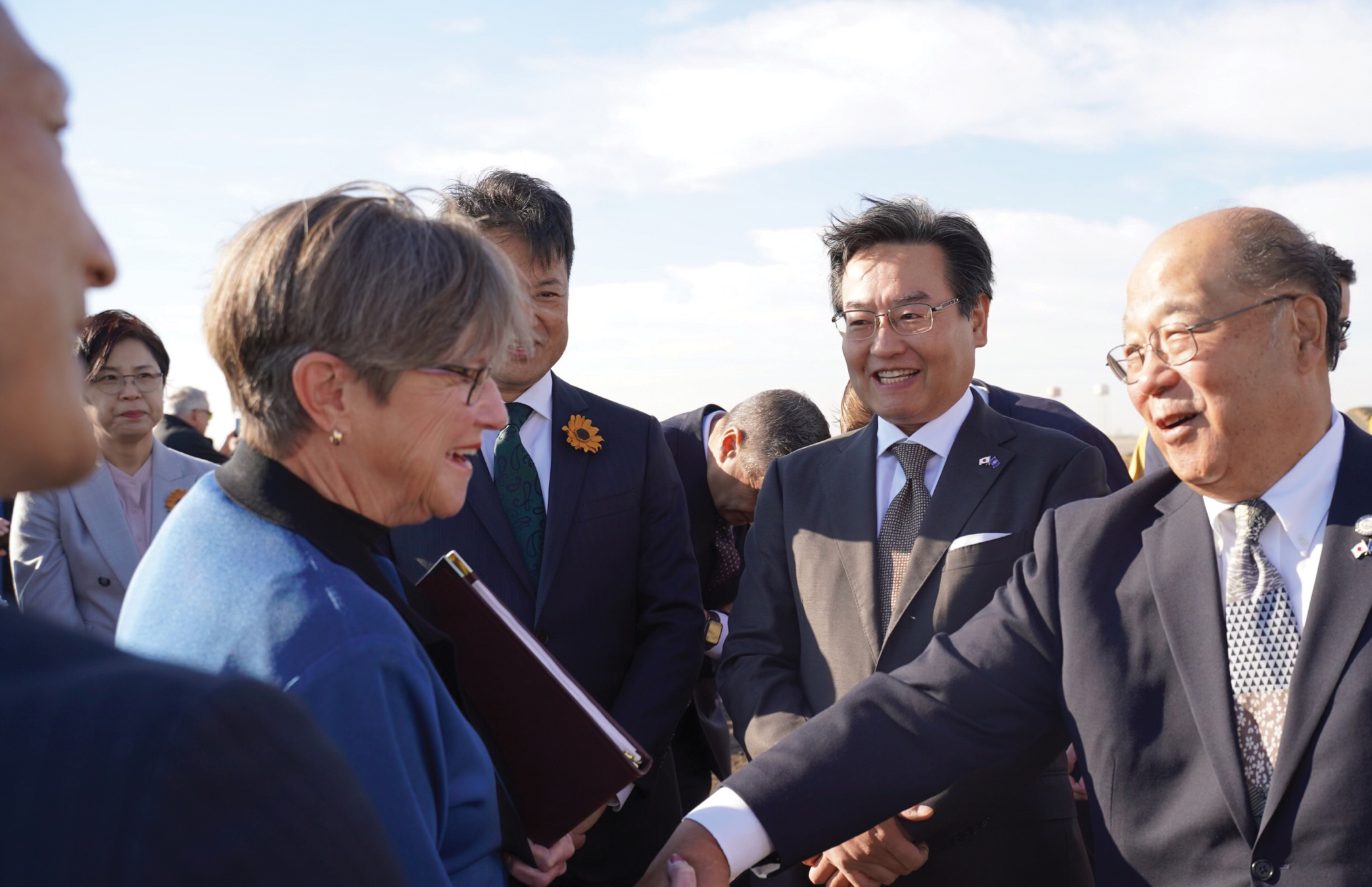
Kansas Governor Laura Kelly congratulates Panasonic Energy Co. leaders at the November 2022 groundbreaking in De Soto for a project that will create 4,000 jobs and bring up to $4 billion in investment to the state.
Photo courtesy of Kansas Commerce
APEX modification and the film industry tax credit are the only legislative measures currently under consideration, but the governor and her team continue to work on other aspects of economic development.
“We know that we cannot continue to bring jobs here if we don’t increase the housing supply available for employees and their families,” she relates. “We need to make sure we have enough child care slots for these families, and we need to have a well-trained workforce to fill those jobs. We have lots of things in motion in all those areas.”
In the workforce arena, for example, Gov. Kelly recently created the Office of Registered Apprenticeship that already has more than 3,500 Kansans enrolled.

Capital Dome in Topeka Kansas Statehouse
Photo: Getty Images
“This is great news for our families and also our businesses,” she says. “We will be working with our higher education institutions, our unions and others to ensure that the program will do a lot to ensure that it puts a dent in their workforce shortage.”
How does it work?
“We created this office which is housed in the Department of Commerce to form close relationships with our businesses, our unions and our higher education career and tech schools to partner with all of them so we can have a number of apprenticeships in high-wage and high-demand areas,” the governor explains. “We’re doing what we do best, partnering with other stakeholders to facilitate their efforts to increase the workforce. We’ve had some apprenticeship programs ongoing in the state on a less visible scale that are usually run through our unions. But companies do go directly to that source. By centralizing all of this, having a one-stop shop will make it a whole lot easier for businesses to let their needs be known and target the apprenticeship programs that are training up workers they need.”
"Kansas has never been in better fiscal shape than we are right now.”
— Governor Laura Kelly
Fiscal Fitness
How well a state is doing financially is less discussed in location searches than such factors as workforce availability, housing supply and infrastructure. But it matters. Site Selection asked Gov. Kelly to weigh in on that topic in case investors looking at Kansas are wondering.

“Kansas has never been in better fiscal shape than we are right now,” she says. “That was coming off a really tumultuous eight years after my predecessor implemented the tax experiment that really tanked our economy in our state. Over the past four years and continuing now, we’ve been able to have balanced budgets every year that also left very healthy ending balances. We’ve been able to build our rainy day fund, which was essentially nothing when I got into office, to $1 billion already.
“We expect by the end of this legislative session we will have at least another $500 million in there, perhaps even another $1 billion,” she says. “That’s aside from the other $2 billion to $3 billion we have in our ending balance. We’re on very safe and secure ground which has allowed us to provide tax credits and some tax cuts. Good things are going on right now that will continue to keep Kansas on an upward trajectory.”
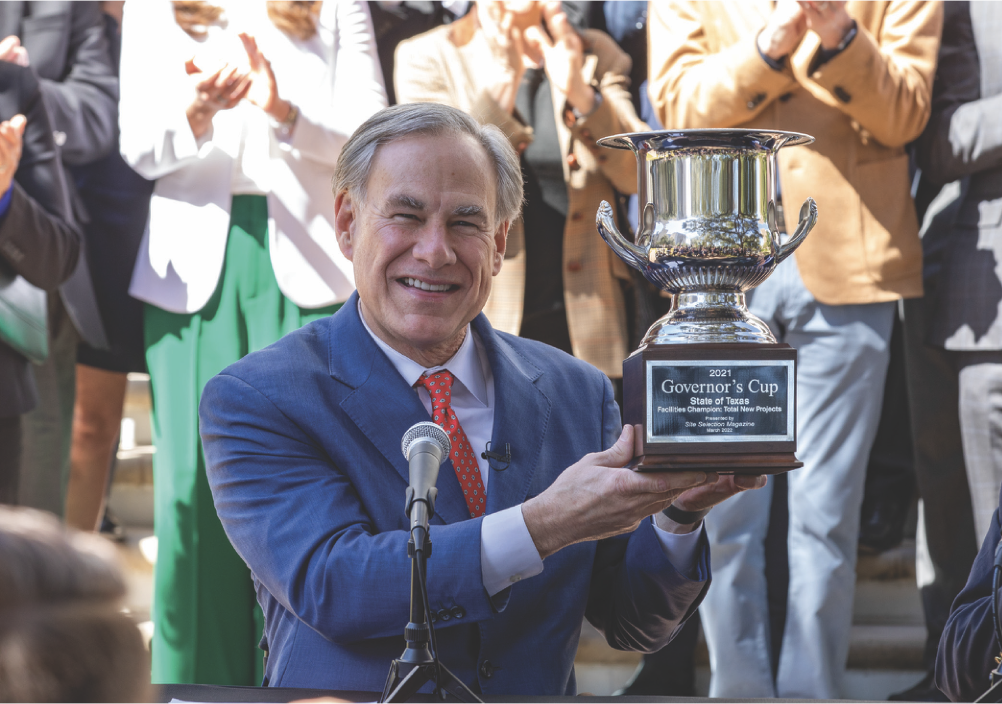
Governor Abbott holding Texas’ 10th Governor’s Cup last year
Photo courtesy of the Office of the Governor
TEXAS
For the 11th year in a row, Texas claims the Governor’s Cup for total qualified projects. That’s not really a stretch when you consider the Lone Star State’s economy is larger than that of Canada, South Korea and Australia. If it were a nation, it would be the 9th largest by GDP. Texas’ workforce is more than 14.5 million strong, and it’s home to 271 corporate headquarter relocations since 2015, the same year Greg Abbott became the 48th governor of Texas.
In February, Site Selection conducted an email interview with the governor to get his take on Texas’ success, the issues at play in 2023 and what lies ahead on the Texas economic landscape.

View of Austin, Texas Skyline and Colorado River
Photo: Getty Images
Congratulations on claiming Texas’ 11th consecutive Governor’s Cup. Your thoughts?
Gov. Abbott: Thank you. I am proud to once again accept the Governor’s Cup from Site Selection Magazine, recognizing Texas as the nation’s leader in attracting job-creating business investments from across the country and around the world to our great state.
When choosing where to relocate or expand their businesses, more and more entrepreneurs and business leaders find themselves here in Texas. They recognize the competitive business advantages found only in Texas. And they are in good company. Texas is the headquarters of headquarters. We’re now home to more Fortune 500 company headquarters than any other state in the nation, along with hundreds of publicly traded firms and over 3 million small businesses and startups.
I congratulate the exceptional economic development teams at the local, regional, and state level who work so diligently to attract and retain these growing businesses and the jobs they create in communities across Texas. As we celebrate 11 years of excellence with another Governor’s Cup win, we look to the future. Working together, we will build the Texas of tomorrow.
You mentioned in your State of the State address that to keep Texas the best state for business, your local communities need new economic development tools this session. Which tools do you want to make available?
Gov. Abbott: Texas leads the nation in attracting job-creating relocation and expansion projects, winning the Governor’s Cup every year that I’ve been Governor. There are several programs within my Economic Development & Tourism Office that focus on attracting new jobs, capital investment, and visitors to Texas. Together with local and regional economic development partners, these initiatives have helped make Texas the national leader for economic growth and job creation.
But we cannot be complacent. Texas must remain a leader in our country and across the globe by continuing to lead with major capital investments in critical industries such as advanced manufacturing and energy production, specifically from companies like Samsung, Texas Instruments, and Tesla. The “Texas Miracle” has remained a strong beacon thanks to a talented workforce, robust infrastructure, innovative technology development, and a business-friendly regulatory environment.
In order for Texas to remain the economic engine of the nation, we must continue to work collaboratively with local economic development organizations and business communities and maintain strategic economic development tools needed to attract the top businesses to the state.
"When choosing where to relocate or expand their businesses, more and more entrepreneurs and business leaders find themselves here in Texas. They recognize the competitive business advantages found only in Texas. And they are in good company. Texas is the headquarters of headquarters.”
— Texas Governor Greg Abbott
I look forward to working with the Texas House and Senate this session to develop new economic development tools to continue attracting major capital investment and manufacturing to Texas while also incentivizing the creation of new energy production.
You also said in your address that local businesses will flourish even more if we reduce the gridlock in our courts by creating specialized courts with the expertise to deal with complex commercial litigation. Do you anticipate any opposition to this?
Gov. Abbott: Creating a specialized court to handle complex commercial litigation in Texas will further strengthen our ranking as the best state in the nation to do business. Texas already has over 200 specialized courts at the trial level, including courts designated to hear probate, juvenile, veterans and family law matters. Having judges that specialize in complex areas of commercial litigation will create more predictability in Texas law and free up the dockets of general jurisdiction courts in Texas.
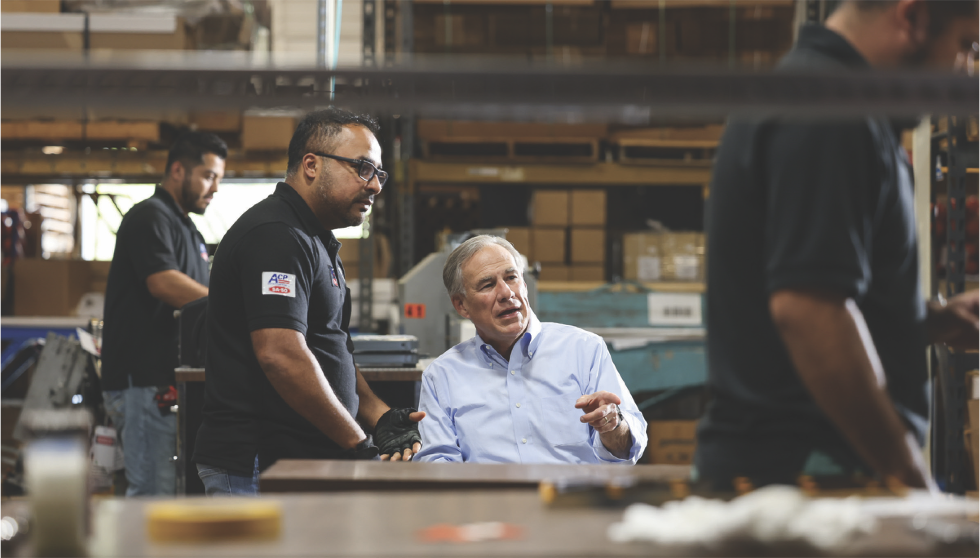
Governor Abbott pays a visit to ACP/SA-SO, a manufacturer of traffic, safety, and facility products based in Arlington.
Photo courtesy of the Office of the Governor
You’ve said your goal is to ensure that every Texan is prepared to succeed in high-demand industries like technology, healthcare, and energy and that in this legislative session Texas will reward community colleges that produce skilled, employable Texans. How will this work?
Gov. Abbott: To meet the needs of a growing economy, Texas must have a regular pipeline of skilled workers. Texas is already investing heavily in reskilling and upskilling programs to bolster our job training programs and prepare Texans to excel in good-paying careers. We are giving students the ability to walk out of these programs into a good-paying career that can help them support their family and contribute to their community.
Community colleges play an integral role by providing credentialing and certification options. The Texas Commission on Community College Finance (TXCCCF) developed recommendations that are aligned with workforce needs through performance-based funding, access to financial aid, and startup grants for high-demand programs to quickly meet the needs of communities and Texas.
Texas can lead the nation in moving to a performance-based funding system for community colleges. The need for skilled labor has never been greater. Working with the Legislature, we can provide the resources necessary to fully implement the TXCCCF recommendations.
You have identified cutting property taxes as a legislative priority in the legislature this year. What else is on your agenda?
Gov. Abbott: Thanks to hardworking Texans, our $2 trillion economy is the ninth-largest economy in the world. We also lead the nation in energy production, exports, and high-tech exports. Our robust and growing Texas economy has produced another record: We now have the largest budget surplus in the history of Texas. But that money does not belong to the government. It belongs to the taxpayers.
We will use that budget surplus to provide the largest property tax cut in Texas history. While we have passed property tax reform every session I’ve been Governor, there is more we can do to provide even more lasting tax relief to homeowners and businesses across the state.
"We now have the largest budget surplus in the history of Texas. But that money does not belong to the government. It belongs to the taxpayers.”
— Texas Governor Greg Abbott
In my budget, I have proposed using $15 billion of the budget surplus to cut property taxes. The House and Senate have also made the same proposals. We must now ensure that it provides lasting property tax relief. We must also provide relief to small businesses by increasing the business personal property tax exemption and require local government debt be passed by a two-thirds supermajority of the local governing body.
With Texas doing so well financially, is there pressure to scale back on incentives for major projects?
Gov. Abbott: We must use every tool in the toolbox to help communities across our great state attract capital-intensive expansion and relocation projects that create good-paying jobs in the industries that are critical for the future of our state and our nation, especially in the advanced manufacturing, energy, and semiconductor industries.
What impact is the border crisis having on companies wanting south Texas locations? The stress on public services and resources must be on their minds.
Gov. Abbott: Because of President Biden’s refusal to secure our nation’s southern border, every community is a border community. Texas has already seized enough fentanyl to have killed every man, woman, and child in America. Until the Biden Administration steps up and secures the border, Texas will continue taking unprecedented action to protect our communities and stop the smuggling of deadly drugs, weapons and people into Texas.
Can you speak to water supply in Texas, an issue many states are grappling with?
Gov. Abbott: Over the last decade, Texas has made significant investments in road, water, and energy infrastructure. As our state gains more than 1,000 people a day, a strategy to expand and improve the state’s infrastructure is crucial. With a historic surplus, there is no better time to consider capital investments to fuel the growing economy and ensure Texans can efficiently get to-and-from work and school, have clean drinking water, connect to broadband internet, and access affordable and reliable energy.
"Over the last decade, Texas has made significant investments in road, water, and energy infrastructure. As our state gains more than 1,000 people a day, a strategy to expand and improve the state’s infrastructure is crucial.”
— Texas Governor Greg Abbott
The State Water Implementation Fund for Texas (SWIFT) has already fast-tracked state water plan projects by offering a unique and cost-effective financial assistance avenue. Over the next 50 years, the original $2 billion appropriation will be leveraged with revenue bonds to finance approximately $27 billion in water supply projects. With nearly $10 billion committed to-date, I look forward to working with the Texas Legislature to allocate additional funds to SWIFT and other state-funding mechanisms.


It’s fascinating that half the corporate relocations since 2015 have come from California.
Gov. Abbott: Freedom is a magnet. We see evidence of this each day as global brand leaders move their headquarters from California to Texas. The business advantages found only in Texas grow more than the bottom line. When freed from over-taxation and over-regulation, new ideas and commerce can flourish.
As I talk to business leaders and entrepreneurs each week, they point to that freedom and our welcoming business climate as the Texas advantages that allow their companies to grow and their employees to succeed in our great state. Those unmatched advantages are why “Made in Texas” is such a powerful global brand and why Texas leads the nation in attracting capital investments, including over 270 new corporate headquarters since 2015 — with more to come.
And those advantages are the reasons why Texas is growing. Now at 30 million Texans and counting, more than 40% of our population growth is newly born Texans. They represent a continuing strong workforce, as Texas is by far the stickiest state: More than 80% born in Texas stay in Texas.
Depending on who you talk to, we’re in a recession or about to be. How does a Texas location help companies weather one?
Gov. Abbott: Texas truly is America’s economic engine. We stand apart as a model for the nation. Perhaps the greatest testament to the strength of Texas can be summed up in four simple words: More Texans are working. More Texans are working today than ever before in our state’s history as we lead the nation in job creation. In fact, more Texans are working today than 46 other states have residents.
While the nation faces economic headwinds, Texas leads all states for jobs added last year thanks to strong, continued business confidence in Texas’ pro-growth economic policies.
In Texas, we want businesses to succeed. When businesses succeed, Texas succeeds. With no corporate income tax and no personal income tax in Texas, businesses are free to flourish and create greater economic opportunities for Texans. To continue to attract and retain business capital and grow even more jobs, we will continue to invest in education, workforce development, infrastructure, and the tools needed to attract job creators for the Texas of tomorrow.
What can readers look forward to in 2023 as they weigh a Texas location versus elsewhere in the South-Central region?
Gov. Abbott: Texas is in competition with the world. We continue to be the best place for businesses to build and expand, thanks to our strong and growing workforce, easy access to global markets, robust infrastructure, and predictable regulations. As a result of our pro-growth economic policies — with no corporate income tax and no personal income tax — Texas continues to lead the nation for job-creating business investments. With even more business expansion and relocation projects in the pipeline, we look forward to more opportunities to come.
From Data Systems to Life Systems
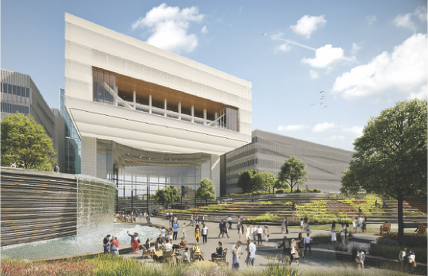
Rendering courtesy of NexPoint
Among the hot markets in the Dallas-Fort Worth metro over the past decade, Plano has been one of the hottest for corporate location and expansion. But even freshly expanded places benefit from renewal.
In February, Dallas-based alternative investment firm NexPoint announced plans for TxS District, a proposed 200-acre life sciences development centered around the former Electronic Data Systems campus in Plano, Texas. The project, named to signify “Technology x Science,” is designed to foster innovation and collaboration among companies and institutions across the life sciences sector.
TxS District would add to the 91-acre EDS main campus an additional 109 acres in the Legacy neighborhood. In total, the project would create over 4 million sq. ft. of lab, office and therapeutic production space across four phases of construction, NexPoint said. The firm “believes the proposed project can be achieved through a public-private partnership” and is engaging with the city about the proposed project’s impact on the surrounding area.
“Not only would this project be a major economic catalyst for the region, but it would also establish North Texas as a leader in life sciences,” said James Dondero, NexPoint founder and principal.
“The TxS project would be unique in its ability to support life science companies at any point in the process: discovery, early stage development, and commercialization,” said Matt Daniels of JLL, which NexPoint has engaged as the project’s leasing agent. “With cutting-edge research facilities and new federal policies promoting the repatriation of drug manufacturing, and a tight labor market in coastal life science hubs, Plano is poised to become a top choice for companies seeking expansion and solutions.”
According to a September 2022 report from Texas Economic Development & Tourism (EDT) within the Office of Governor Abbott, in the five years up to that point, Texas added more than 700 new biotech-related establishments and nearly 9,500 new jobs in the sector. Overall, the state is home to 6,100 biotechnology-related manufacturing and R&D firms, 105,000 jobs within the biotech and life sciences industry and a network of academic and research institutions that includes seven of the nation’s top 125 medical schools and $6.6 billion in annual R&D expenditures. — Adam Bruns
Boeing Gives STEM Learning a Lift in South Texas
by RON STARNER
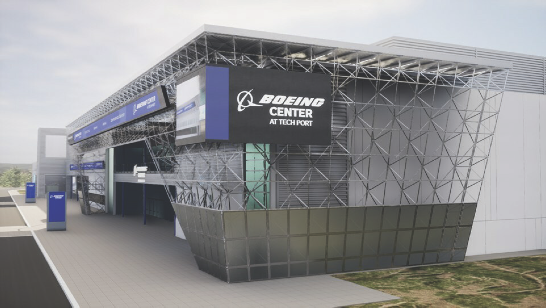
Back in 2001, Boeing considered moving its corporate headquarters from Seattle to Dallas. The world’s fourth-largest aircraft maker eventually selected Chicago, but more than two decades later, Boeing is making a different kind of investment in Texas.
On January 24, Boeing announced that it was partnering with the Kelly Heritage Foundation to expand STEM learning and workforce development in South Texas. The initiative is part of a seven-year partnership that includes $2.3 million in funding to strengthen science, technology, engineering and math education at the new Boeing Center at Tech Port in San Antonio.
Boeing has been refurbishing aircraft at Port San Antonio for more than 20 years; and this latest move will help shore up its future workforce training efforts in the region.
“Boeing is a crown jewel of American business, and I’m honored that Texas is a key part of their company,” said Texas Gov. Greg Abbott during a ceremony at the San Antonio Museum of Science and Technology (SAMSAT). “For nearly 25 years, San Antonio has been home to an aircraft maintenance and modernization hub, where work on the C-17, F-15 and F/A-18 takes place. Port San Antonio now houses 80 employers and 16,000 workers and has a $6 billion impact on the local economy. Boeing Center at Tech Port will introduce young Texans to the advanced technologies that will drive the workforce of tomorrow.”
Stephanie Pope, CEO of Boeing Global Services, said, “This partnership and investment in San Antonio reflect Boeing’s commitment to this community and to supporting U.S. and allied military services. We deliver best-in-class products and services for commercial and government customers, and we know a vibrant STEM curriculum will deepen the bench of local talent we hope to hire in the future. Our workforce continues to grow as we expand our site, and we look forward to our bright future in San Antonio.”
The port covers 1,900 acres in San Antonio and employs more than 16,000 people in the region. Boeing is one of the biggest operators at the port. Statewide, the firm employs more than 5,730 Texans and contributes an economic impact of $1.6 billion annually.
5 Texas Cities Rank Among Top 30 for Corporate HQ Offices
by RON STARNER

Pfluger Park in downtown Pflugerville, one of the rapidly rising suburbs of Austin.
Courtesy of Pflugerville Community Development Corp.
A new study released February 1 shows that five cities in Texas rank among the top 30 locations in the U.S. for corporate headquarters offices in the new post-pandemic economy. The study shows that Frisco, Pflugerville, Sugar Land, Westlake and The Woodlands all rank among the top American cities based upon the criteria used by The Boyd Company Inc., a national site selection consulting firm based in Princeton, New Jersey.
The report looked at all major geographically variable cost factors that are considered in the corporate site selection process. These included labor, real estate, construction, utilities, taxes and travel.
John Boyd Jr., principal of the corporate location advisory firm, said these factors have been even more critical in the post-pandemic economy as companies seek to shave the cost burden created by large empty offices while half or more of their workers do their jobs remotely.
“Nationally, the days of one large, downtown corporate headquarters office are fast disappearing,” said Boyd. “Today, many companies are transitioning to a hub-and-spoke model with one downsized central head office hub and additional smaller spokes — or satellite offices for administrative support. With a reduced head office staff and with other satellite offices performing many of the administrative functions historically carried out at the headquarters site, companies will be increasingly relocating to attractive, smaller market suburban location offering lower operating costs, superior state business climates and growth-oriented demographics to house their new downsized corporate headquarters.”
By doing this, notes Boyd, firms can save millions of dollars in annual operating costs and taxes while being placed closer to top talent seeking prime HQ jobs.
The cost of maintaining a corporate head office of 200 employees in 75,000 sq. ft. of Class A space is around $20 million a year in each of the five Texas markets named by Boyd. This ranges from a low of $19.9 million in The Woodlands to a high of $20.4 million in Frisco.
Florida had the most cities in the top 30. Eight Sunshine State markets cracked this elite ranking in the Boyd study: Aventura, Boca Raton, Lake Mary, Naples, Palm Bay, Ponte Vedra, Sarasota and Sunrise.
The five ranked Texas locations are based in one of three markets. Frisco and Westlake are suburbs in the Dallas-Fort Worth-Arlington metroplex; Pflugerville is a suburb of Austin; and Sugar Land and The Woodlands are suburbs of Houston.
Corpus Christi Port Sails into Clean Energy Future
by RON STARNER
Seaports traditionally are not thought of as green energy giants, but one major port on the Gulf Coast of Texas aims to change that. The Port of Corpus Christi continues to pursue designation by the U.S. Department of Energy as a Regional Clean Hydrogen Hub.
On January 9, the DOE officially invited the port to submit a full application for its Horizons Clean Hydrogen Hub (HCH2) through the federal Regional Clean Hydrogen Hubs Program.
The Port of Corpus Christi is the prime applicant for the HCH2 designation and would serve as the official home of more than 20 discrete clean hydrogen production projects. Original paperwork submitted to DOE in November named 30 partners in the project. These range from Ambient Fuels and Apex Clean Energy to Mitsubishi Corp. and Plug Power.
HCH2 projects will use and add to the 110 miles of existing hydrogen pipelines in the region. Many existing operations around the port already use hydrogen in the petrochemical refining process.
“The Port of Corpus Christi is thrilled and grateful that our hydrogen hub development concept has resonated with the U.S. Department of Energy,” said Sean Strawbridge, CEO for the Port of Corpus Christi. “As a public port authority with large tracts of available land and a burgeoning industrial complex, we find ourselves in a unique position to integrate multiple links in the clean hydrogen production value chain creating efficient H2 campuses offering high-efficacy returns on these precious federal investments.”
The goal of the federal program is encourage the development and deployment of new clean energy delivery systems.
“The Port of Corpus Christi is leveraging its prominence in the energy marketplace to accelerate hydrogen market adoption and realize substantive decarbonization of key industrial sectors,” said Jeffrey Pollack, chief strategy and sustainability officer for the Port of Corpus Christi. “We’re building on our long history of community engagement as the economic engine of the region to create new jobs and accentuate community benefits that truly reflect community priorities.”
On February 14, the Port of Corpus Christi and the Trans Permian H2Hub announced that they would be combining their two hydrogen hubs into a single application, with the port becoming the prime applicant for the newly joint entity.

